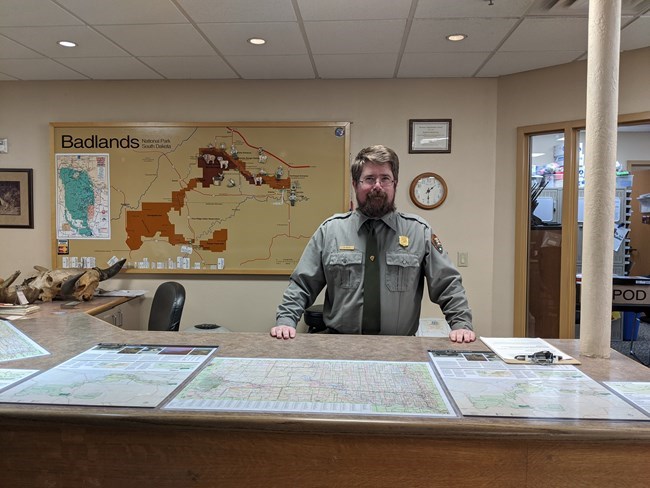Last updated: May 9, 2025
Thing to Do
Visit the Ben Reifel Visitor Center

Pets are permitted in Badlands National Park with some restrictions. Pets must be kept on a leash no more than six feet in length at all times. Pets are only permitted in developed areas, such as campgrounds and picnic areas, and other areas open to motor vehicles, such as gravel and paved roadways, roadway corridors, and parking lots. Pets are prohibited from hiking trails, public buildings (i.e. visitor centers), and backcountry areas, including the Badlands Wilderness Area, and areas with prairie dog colonies. Pet etiquette dictates always cleaning up animal waste and disposing of it in trash receptacles.
The museum exhibits also contain tactile exhibits and audio-visual elements for those who are blind or low-vision. Ask rangers at the front desk about audio-described and text-only brochures. For captioned and audio-described versions of the park film, talk to the rangers at the front desk.
Certified service animals are the only animals allowed in the visitor center. Emotional support animals are not service animals and are not allowed in the building.

NPS Photo

NPS Photo
Information Desk
At the Ben Reifel Visitor Center, visitors to Badlands National Park can get answers to their questions from rangers at the information desk. There, park staff can distribute maps and other park materials, provide directions and local area orientation, hand out Junior Ranger booklets, and answer any questions you might have about earth science, wildlife, history, and more. There is also a self-serve passport stamping station at the information desk.If you're not stopping by the Ben Reifel Visitor Center during your trip to the Badlands, you can also access rangers at the White River Center, via email, or by calling (605) 433-5361.
Museum Exhibits & Park Film
Whether you're curious about what you've already seen in the park or you're just arriving and want to get a preview, you're sure to learn something new in the Ben Reifel Visitor Center's museum exhibits. From the mosasaurs which swam through the Badlands area 75 million years ago to more recent history with the Lakota who live south of the park today, these exhibits cover a vast time period and all of the different stories which come together to make the Badlands special. These exhibits include audio-visual elements and tactile displays.
At the visitor center, you can also catch the park film, The Land of Stone and Light. In the spring, summer, and fall, the park film runs on a 25-minute loop. In the winter, the park film is shown as requested -- just ask the ranger at the front desk to play it for you. Captions and audio-descriptions are available on the park's multimedia webpage. Ask the rangers at the desk about these options when you visit.

NPS Photo
Fossil Preparation Lab
If you're interested in the paleontology of Badlands National Park, don't miss the Fossil Preparation Lab. There, you can chat with park paleontologists as they gradually remove rock from specimens to reveal fossils. Park rangers are also available in the lab to answer any questions you may have about the incredible fossil animals of the Badlands. With millions of years of fossil history recorded in the park's rock formations, there are plenty of fossils to learn about!
NPS Photo / Alex Ennes
Park Bookstore
At the Badlands Natural History Association Bookstore, you can purchase books to learn more about the park as well as souveniers to remind you of your time at the Badlands. Badlands Natural History Association uses all profits to support park programs like internships, volunteering, and more.Who was Ben Reifel?
Benjamin Reifel, also known as Lone Feather, was the first Congressman elected with Lakota heritage, representing South Dakota’s 1st congressional district. Mr. Reifel belonged to the Brule (or Burnt Thigh) tribe. He was also the only Native American Congressman during the 1960’s. He served 5 terms from 1961-1971.
Reifel decided not to seek reelection in 1971, but still remained in government service during the administrations of President Richard Nixon and President Gerald Ford. During this interval, he spent time serving as Special Assistant for Indian programs to the Director of the National Park Service.
